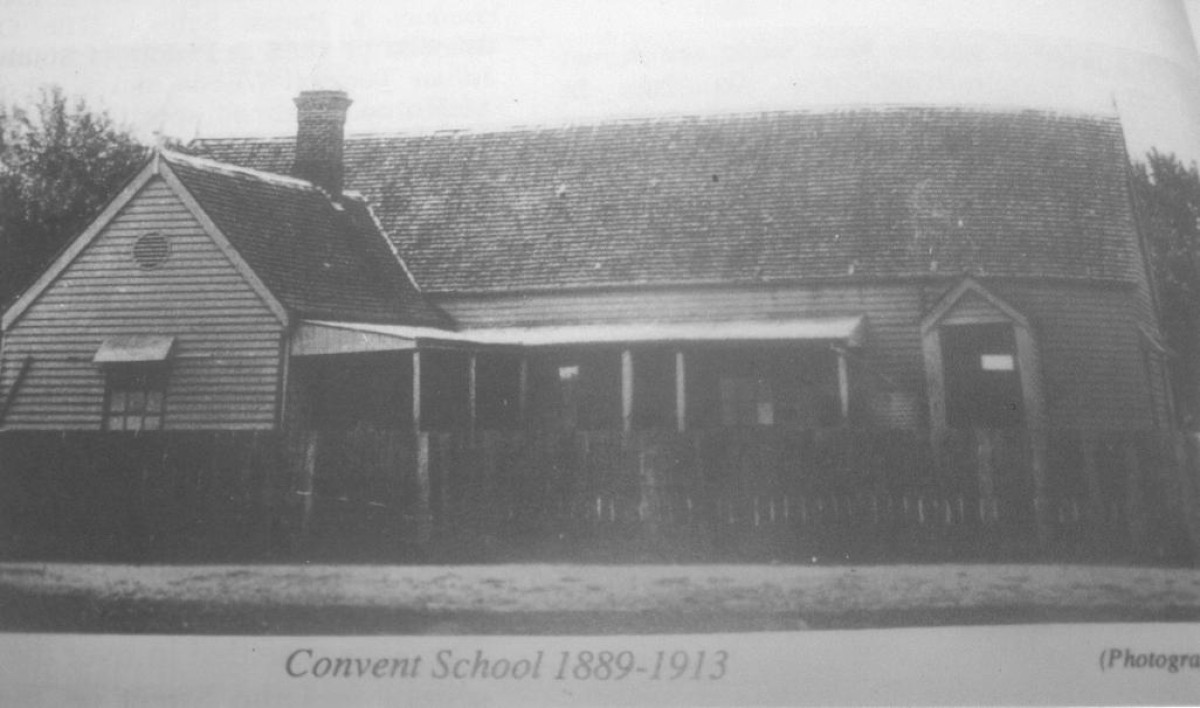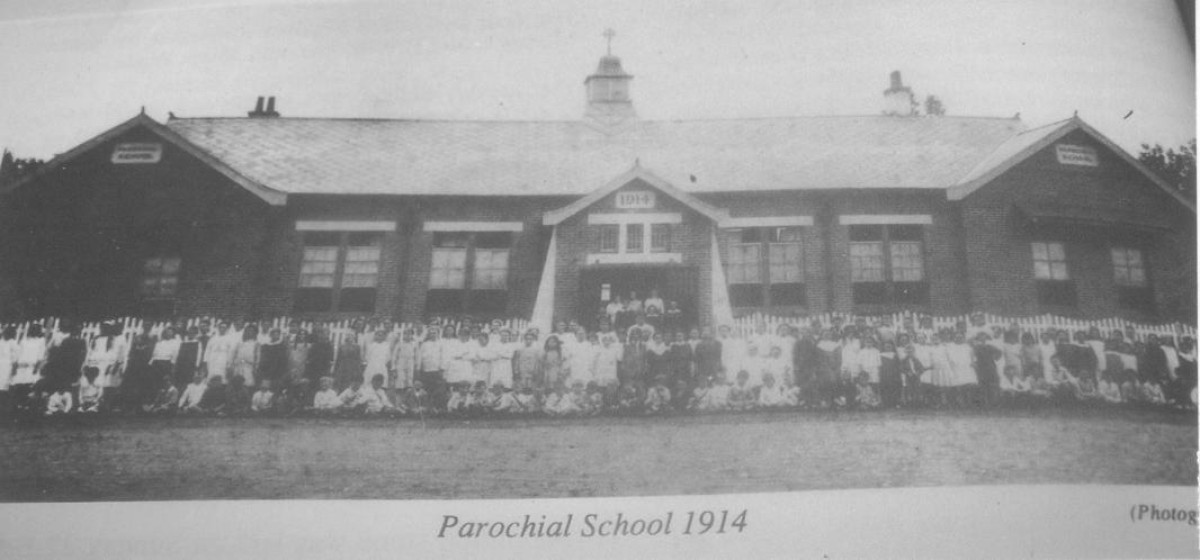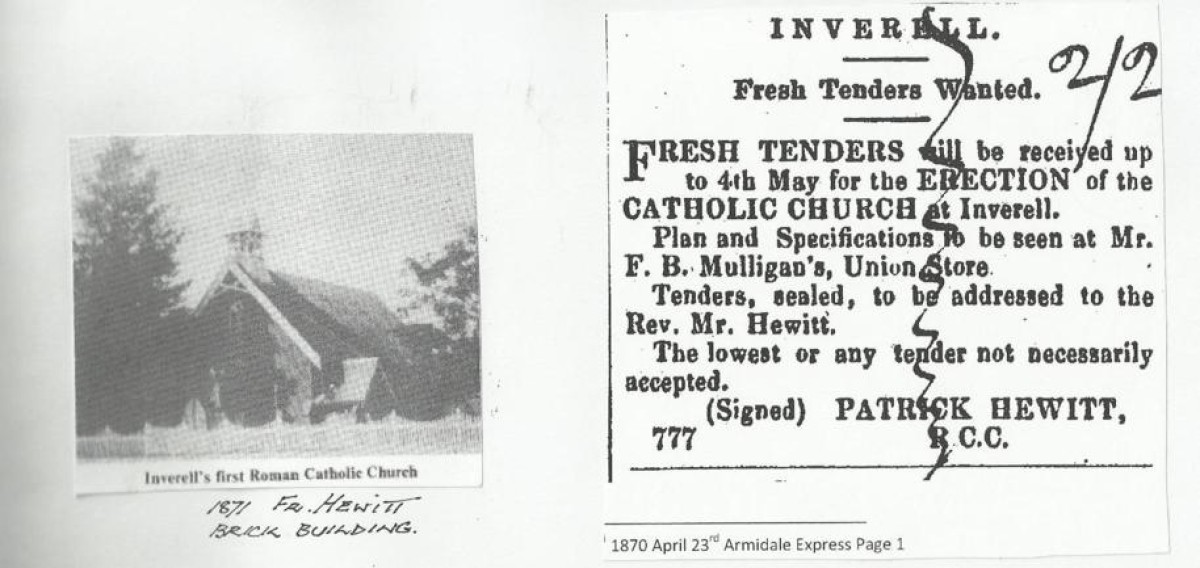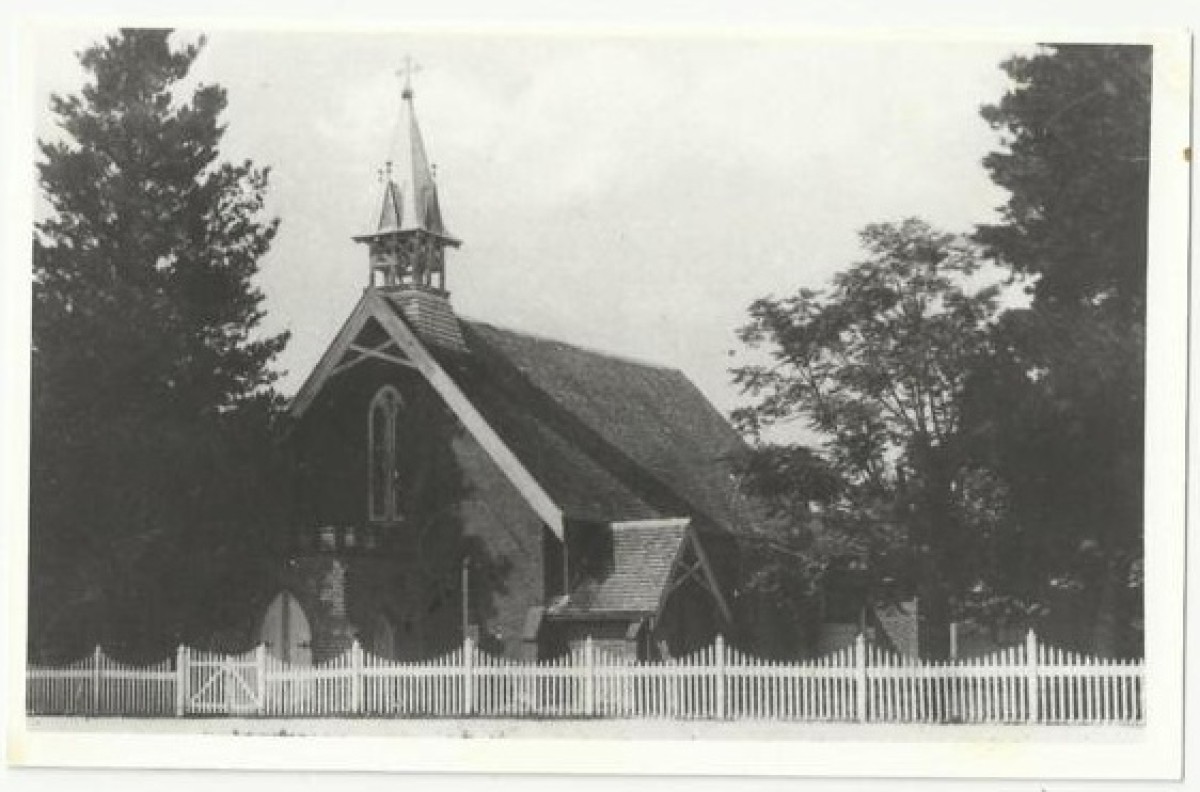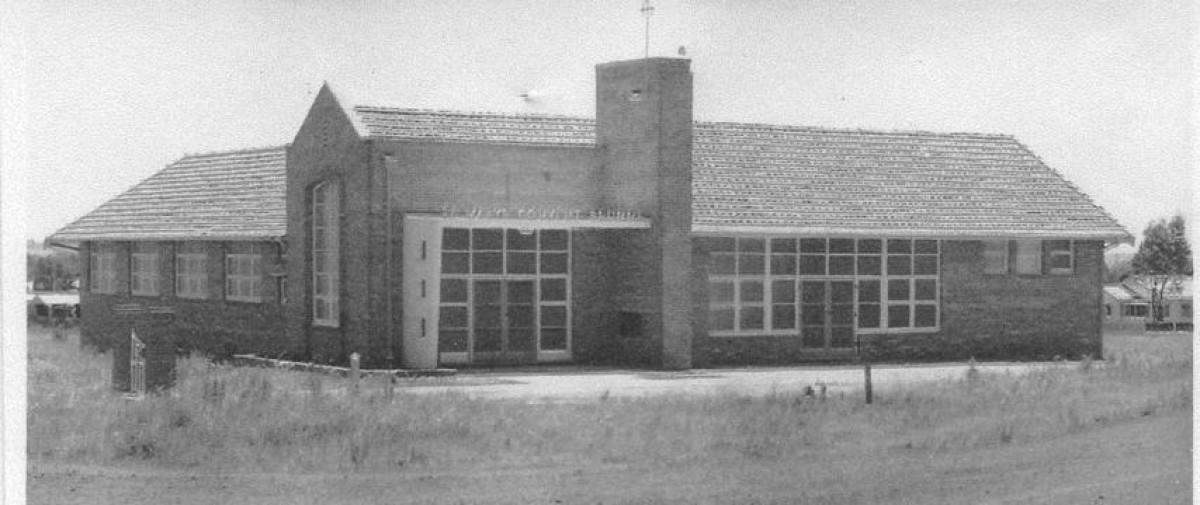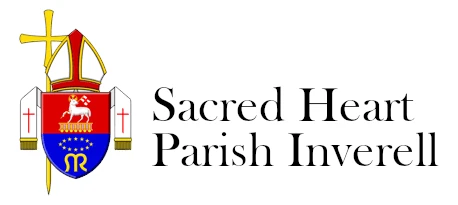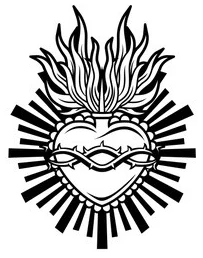History
This brief history is taken from "Celebrate: 150 years with the Inverell Sacred Heart Parish" published in 2018.
After the establishment of the Catholic Church in the Sydney area and the first Bishop, Bede Polding OSB, it was in 1838 that Dean Lynch was travelling to the New England area. He rode on horseback over 300 miles from his presbytery in Maitland, visiting all the infant settlements in the area. He visited Byron Station and Newstead where Irish Catholics worked on the vast pastoral leases.
In 1851, Fr Tim McCarthy became the first resident priest at Armidale and the Inverell district was part of his pastoral route. He replaced Dean Lynch and he travelled even further to the border of Queensland.
In 1861, the first public school was established in River Street, Inverell. In that same year a sawn timber Catholic Church was opened at Bundarra but it was another 19 years before a resident priest came to the town. In those years, Fr John Davis conducted Masses and visited homesteads in that locality.
In 1868, Fr Francis Wenceslaus McLaughlin became the first Parish Priest of Inverell. He was only 26 years old and had been ordained the year before. He lodged and kept his horses with Senior Constable Festus John Farnsworth in the police barracks as there was no presbytery as yet. His vast parish in this district took him to Manilla, Goondiwindi, Moree and Wellingrove. Sometimes he travelled by sulky and at other times on horseback through all weathers. Fr McLaughlin became seriously ill at the end of 1868 and died in January 1869 from tuberculosis. His monument is very prominent in the early Catholic portion of the cemetery and he was the first person to be buried in that section.
In April of 1870, tenders were called by Fr G Hewitt for the first Catholic Church in Inverell and John Wilshire Pender, an architect from the Hunter Valley submitted his drawings. Fr Hewitt began raising money to erect the much needed church. By December of 1870 Mr Cheadle was appointed the successful contractor for the new church. On 15th June 1871, Bishop O'Mahony visited Inverell to offer Holy Mass in the almost completed church in Otho Street. There was neither floor nor roof but it seems that the weather was fine as His Lordship delivered a long, impressive and eloquent address to the large congregation. Bishop O'Mahony returned to dedicate and officially open the new church on 20th December 1871. Sadly, Fr Hewitt had been transferred to Sydney, but the new Parish Priest, Fr John Kelly, was there to welcome and host the Bishop.
The Inverell Argus described the new church as "a fine brick building, the interior walls were whitewashed and the furniture made of cedar. It was a credit to the town. Mr Cheadle, the contractor and Mr Hilton, the bricklayer, were praised for their excellent work."
In 1882, a Catholic church was established at Tingha, the first priest being Fr Joannes Pauley who was stationed at Bundarra.
The first Catholic school in Inverell was a wooden building and was staffed by the Sisters of St. Joseph. It replaced the original school which was destroyed by a severe storm on December 11, 1888. The Sisters of St. Joseph withdrew to Tingha in December 1890. The Sisters of Mercy commenced teaching in Inverell on January 12, 1891.
January 1891, saw a Catholic mortuary chapel built in the old Catholic portion of the Inverell Cemetery. It was overseen by Dean Mitchell PP and cost £80. It was said at the time that it was the second Catholic mortuary chapel built in the colony of New South Wales, but there is no verification of this. His Lordship, Rev Dr Torreggiani, Bishop of Armidale, blessed the building.
St David's Catholic Church, Cherry Tree Hill, was opened and blessed in 1892 by Bishop Torreggiani, accompanied by Dean Mitchell, PP of Inverell, and several Sisters of Mercy. The Gothic featured Church was built on Owen McCosker's land.
Dean Mitchell died in October 1893 in St Vincent's Hospital, Sydney, and his body was brought back to Armidale to be interred. His good friend, Bishop Torreggiani, conducted the Requiem Mass in the Cathedral.
In 1897, Mother Mary Benignus Healy died aged 32. She was Mother Superior at the Sacred Heart Convent, Inverell. She is buried in the old Catholic portion of Inverell cemetery in the shadow of the then mortuary chapel.
1900 saw the opening of the boarding school for boys and girls at the convent and this continued until 1962.
On January 21st 1901, a meeting of Inverell parishioners was called, as once again the church was too small to serve the ever growing congregation. A committee was formed to discuss the possibility of building a new church. There were differing opinions to where the new church should be situated. Some said the church site should be facing Victoria Park. Some thought that the new church should be erected on the site of the existing church facing Otho Street. The vote was carried by a majority of 58 to 17 for this option. The new church took three years to build on the site where the present Shire Council building is today.
In 1904 upon the death of Bishop Torreggiani, Rev Fr Patrick Joseph O'Connor succeeded as Bishop of Armidale.
In 1909, the Sisters of Mercy opened their new convent in Vivian Street. The builder was Mr Nott of Armidale and additions for boarders were made in 1928.
The year 1912 saw the death of Sister Aloysius RSM, who was the founder of the Inverell Convent of Mercy.
In 1913, the foundation stone was laid by the Bishop of Armidale for the new Catholic Church in Bundarra, St Mary of the Angels. Also, two new altars for Sacred Heart Church were presented to the Parish and were dedicated. The Sacred Heart Altar was a gift from Casper Limberg and family in memory of the late Mrs Margaret (Goldman) Limberg. Our Lady's altar was a gift of the Condren family in memory of the late Miss Sullivan, a sister of Mrs Condren of Gum Flat.
St Patrick's Church at Ashford was built in 1913 and opened by Fr John English. Ashford became a parish in 1938 with the arrival of the first resident priest on April 12th 1938.
On February 24th 1914, the foundation stone was laid of the Sacred Heart School on the corner of Rivers and Vivian Streets. The school was officially opened in October that year. This was a busy year for the Catholic parishes with the opening of the Bundarra Catholic Church by Bishop O'Connor on April 29th. The Catholic Presbytery was opened on June 13th next to the church in Otho Street.
The first Lebanese families arrived in Inverell in the 1920's. Jacob Haddad was one of those. He was well known in Inverell and district as a howler, later owing a general store.
A high school was added to the existing school buildings in 1930. It consisted of two large brick rooms, parallel to Vivian Street. One room housed First & Second Year and the other Third Year – the Intermediate class.
In 1938, Bishop Coleman formed three new parishes: Warialda, Ashford, and Walgett. In the same year, four young priests arrived in the diocese. They were Frs Lawrence Cosgrove, James Conroy, William Corr, and Paul Geary. By the end of that year there were 38 priests within the diocese, the highest number on record.
In 1947, a presbytery was built for the parish priest at Ashford with money raised by the parishioners. Fr Lawrence Cosgrove added the back section of the house at his time there between 1953 and 1957. That house has been sold and renovated by its new owners but the original section of the house is still visible. Fr Robert Watson was a marvellous carpenter and he constructed the present altar at St Patrick's at Ashford as well as furniture in the sacristy, the seats and the kneelers.
In 1949 Inverell welcomed Monsignor Condon to the parish. He was assisted by Fr Cosgrove and Fr Clarrie Fisher.
In 1952 a new school and Catholic Church was built at Tingha by E.J. Walker and was dedicated by Bishop Doody.
St Mary’s Church at Ross Hill was officially opened as a School-Church on Sunday, Nov 1, 1953 by Bishop Doody. The first intake of students did not take place until first term 1954. The school was built to accommodate sub-primary and infants children living west of the River in order to relieve overcrowding at Sacred Heart School. After completing Year 4, the students moved down to Sacred Heart School. This continued till 1963 when boy students attended Holy Trinity from year 4, girls still stayed at Sacred Heart. In 1969 St Mary’s became an all- girls Primary School from years 4-6. In 1975 the school closed and the pupils transferred to Holy Trinity.
In 1956, government subsidies allowed school bus services to travel to outlying areas in the district bringing children into the Inverell schools including St Mary's
1957 saw Fr James Healy arrive in Inverell. He remained until 1968. Other priests in Inverell at the time were Frs Stan Campbell, Bede Ryan, Reg McKervey, Bruce McPherson, Thomas Shanahan, Frank Le Fever, John Carey and Ronald Perrett.
In 1962, the first branch of the Catholic Women's League in the Armidale Diocese was formed at Inverell. The State President, Mrs Chandler, came to Inverell to address the gathering of women resulting in the formation of the branch. The Parish Priest at the time was Monsignor Healy and the group's president was Celia Lennon. The following year branches of the CWL were formed in Moree and Werris Creek.
In 1962 the last of the boy students left Sacred Heart school run by the Sisters of Mercy and were enrolled at Holy Trinity School in Moore Street, which opened in 1963. It was staffed by De La Salle brothers from Armidale.
In the 1960's the St Vincent De Paul Society of Inverell moved into newly built premises in Oliver Street, vacated by Mr. Hoon who owned a general store there. This gave the Society room to sell clothing and furniture to those in need.
In 1967, all secondary girls from Sacred Heart School were transferred to Holy Trinity and new demountable rooms were erected at Sacred Heart School. Later these were moved to Holy Trinity. It was also in 1967 that Monsignor Healy resigned as Parish Priest due to ill health. He returned to Ireland where he later died. He had also been Vicar General of the Diocese under Bishop Doody.
In 1975 St Mary's Church and School closed on Ross Hill and the students were enrolled at Holy Trinity.
In 1978, the De La Salle Brothers withdrew from Holy Trinity, although the Sisters of Mercy remained at the school. More lay teachers were being employed. This same year the Sacred Heart School closed and the infants section was built at Holy Trinity School. It was also in that year that the remaining Sisters of Mercy at the Convent moved out to their new premises at 18 Mather Street, not far from Holy Trinity School.
In 1980 there was an auction of surplus goods from the Mercy Convent in Vivian Street and in that same year Fr Bruce McPherson came to the parish. In his time as Parish Priest he organised the building of the third church as we see it today. Unfortunately he did not live to see the completion of the building project as he died of heart failure during a visit to Sydney. His Funeral Mass was the first to be celebrated in the new church, which at the time was not fully completed.
On September 10th 1982, the last Holy Mass was celebrated in the second church in Otho Street.
This church, the presbytery and the Sacred Heart school buildings were all demolished to make way for the new church and presbytery. Meanwhile the priests lived at "Roslyn" on the Glen Innes Road, the former residence of the De La Salle brothers. The new church and the presbytery were blessed and opened on April 23rd 1983 by Bishop Henry Kennedy.
The late 1970's and the 1980's were a time of change and building in the parish but other significant changes were still to come.
In September 1994, the Graman Catholic Church went to auction. On the same day, the Bonshaw Catholic Church was auctioned. They were both sold and are now residential properties.
In October 1998, St Patrick's Church at Ashford celebrated 50 years. The church was built in 1913 but the Parish was created in 1938. In this same year, the residence of the Sisters of Mercy in Mather Street was sold and the Sisters purchased two units at 28 Henderson Street. The original home on this land was owned by the Kelleher family. Sr Coral Hedley and Sr Mavis Dick moved to the new units.
In October 2018, the Sacred Heart Parish at Inverell celebrated 150 years. There was a week of celebrations.
The Parish continues its mission of being a Catholic presence in the town of Inverell and bringing the Catholic faith to the world. We seek to be true to Christ's commands to make disciples of all nations.
